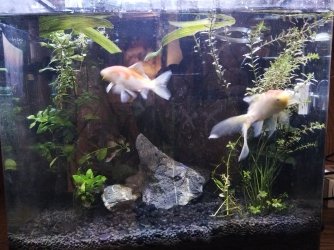Unless you moved the filter media/ materials from your old filter into the new filter, you are cycling the aquarium with fish in it the tank (fish in cycle). This means you will probably get ammonia and nitrite readings for the next 4-6 weeks while the new filter develops colonies of good bacteria that can break down the ammonia and convert it into nitrite and then nitrate.
The easiest way to deal with this is with big (75-90%) daily water changes to keep the ammonia and nitrite levels low while the filter develops the colonies of good bacteria. Once the filter has established you can reduce the water changes to once or twice a week.
Make sure any new water is free of chlorine/ chloramine before it's added to the aquarium.
If you moved the old filter media into the new filter, it will take a few weeks to recover and you should do daily water changes until you don't get an ammonia or nitrite reading.
---------------------
Most of the test results are nothing to worry about. Your pH is above 7 and you have medium hard water, which is ideal for goldfish.
Ammonia is the most toxic substance we test for, and you want to keep that on 0ppm at all times. Ammonia is more toxic in water with a pH above 7.0 but if you do big daily water changes, the level should stay low enough so it doesn't harm the fish.
Nitrite is the next most toxic substance we test for, and it is less toxic in water with a pH above 7.0. Again we try to keep the levels on 0ppm.
Nitrate is less toxic than ammonia or nitrite and you want to keep the levels as close to 0ppm as possible and under 20ppm at all times. Don't bother testing for nitrate while an aquarium filter is cycling because nitrate test kits read nitrite as nitrate and give you a false nitrate reading. If you are using a paper test strip for the testing then just ignore the nitrate reading until the tank has finished cycling.
You should check the tap water for ammonia, nitrite and nitrate. Some tap water has nitrate in and this will mean your tank will always have nitrates because it will come from the tap water. Hopefully your tap water doesn't have nitrates.
You can contact your water supply company and find out if they add chlorine or chloramine to the drinking water. If you have chloramine in the water you will need to use a dechlorinater that neutralises chloramine. It's normally the same dechlorinater that gets used for chlorine but a higher dose rate for chloramine.
---------------------
Just feed the fish a little bit once a day and do big daily water changes. The fish won't starve and the new filter will be good in a month or so.
Unlike mammals and birds that use most of the food they eat to keep warm, most fish take their body temperature from the surrounding water. This means any food they eat is used for movement and growth. This allows fish to go for long periods of time without eating. Fish starving is not common, but fish dying from polluted water caused by too much food is very common.


 (pH 7.8, Hardness 250, Ammonia Nitrogen 0, Nitrate 10-25 and then 50, Nitrite 1, Total Chlorine 0, Carbonate Root 80, Total Alkalinity 120) these readings were done about an hour ago after a 30% water change and adding the Prime and Quick Start. Also add - they have not been fed in 4 days to try and solve the water issues.
(pH 7.8, Hardness 250, Ammonia Nitrogen 0, Nitrate 10-25 and then 50, Nitrite 1, Total Chlorine 0, Carbonate Root 80, Total Alkalinity 120) these readings were done about an hour ago after a 30% water change and adding the Prime and Quick Start. Also add - they have not been fed in 4 days to try and solve the water issues.

